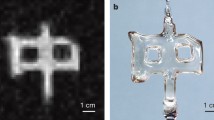Abstract
Based on principle, magnetic resonance imaging (MRI) is a direct molecular imaging modality because all of the possible contrasts of MRI are formed by the decay process after excitation of the polarized spin nuclei in resonance in an imaged subject. The spin nuclei exist in a molecule, such as a proton in a water molecule. The polarized and excited spin nuclei have the same spin frequency fixed by the Larmor equation, which also determines the relation between the center frequency ω and B 0:
where γ is a constant of the gyromagnetic ratio with a value of γ=2.68×108 rad/s/T or after normalization by 2π, then the value of γ=42.6 MHz/T for proton spin. The center frequency ω is usually in a radio frequency (RF) range and the polarized spin nucleus balanced in B 0 can be excited by the RF wave, which is defined as B 1. In order to position the interaction event of the excited spin nucleus, a gradient field of G is needed, which fixes the positions in a Cartesian coordinate system for the imaged subject. The details of the principle, scheme and key technologies for MRI can be found in many references, and some of these can be seen in [1].
Access this chapter
Tax calculation will be finalised at checkout
Purchases are for personal use only
Preview
Unable to display preview. Download preview PDF.
Similar content being viewed by others
References
Bao, S. (2004). On Modern Medical Imaging Physics. Peking University Medical Press.
Haacke, E. M., Y. Xu, Y. C. N. Cheng & J. Reichenbach (2004). “Susceptibility Weighted Imaging (SWI)”, Magnetic Resonance in Medicine 52: 612–618.
Einstein, A. (1989). On a Heuristic Point of View Concerning the Production and Transformation of Light. Princeton University Press.
Le, B. D., R. Turner & P. Douek (1993). “Is water diffusion restricted in human white matter? An echo planar NMR imaging study”, NeuroReport 4: 887–890.
Clark, C. A., M. Hedehus & M. E. Moseley (2001). “Diffusion time dependence of the apparent diffusion tensor in healthy human brain and white matter disease”, Magnetic Resonance in Medicine 45: 1126–1129.
Donald, W. M., A. M. Elizabeth & R. P. Martin (2003). MRI From Picture to Proton. Cambridge University Press.
G. Paolo, V. Ragini & L. Seungkoo (2007). “Diffusion-tensor MR imaging and tractography: Exploring brain microstructure and connectivity”, Radiology 245: 367–384.
Gao, S., X. Wang & S. Bao (2006). “Effect of diffusion time and diffusion gradient strength on the mean diffusivity of water molecules in healthy human brain”, Progress in Nature Science 16: 706–711.
Inglis, B. A., E. Bossart & D. Buckley (2001). “Visualization of neural tissue water compartments using biexponential diffusion tensor MRI”, Magnetic Resonance in Medicine 45: 580–587.
David, N., F. Raymond & H. Baslow (2003). “The apparent dependence of the diffusion coefficient of N-acetylaspartate upon magnetic field strength: Evidence of an interaction with NMR methodology”, NMR in Biology 16: 468–474.
Valette, J. & M. Guillermier (2005). “Optimized diffusion-weighted spectroscopy for measuring brain glutamate apparent diffusion coefficient on a whole-body MR system”, NMR in Biology 18: 527–533.
Graaf, D., K. Braun & K. Nicolay (1999). “Single-scan diffusion trace 1H-NMR spectroscopy”, Magnetic Resonance in Medicine 1827.
Gao, S., Z. Zu & S. Bao (2008). “Interleaving gradient magnetic field method for diffusion weighted spectroscopy”, Chinese Physics Letter 25(1): 325.
Kim, S. (1995). “Quantification of relative cerebral blood flow change by flow-sensitive alternating inversion recovery (FAIR) technique: Application to functional mapping”, Magnetic Resonance in Medicine 34: 293–301.
Lai, S., J. Wang & G. Jahng (2001). “FAIR exempting separate T1 measurement (FAIREST): A novel technique for online quantitative perfusion imaging and multi-contrast fMRI”, NMR in Biomedicine 14: 507–516.
Zou, R., X. Zhang, S. Bao, C. Xie, W. Sun & S. Lai (2005). “FAIREST Perfusion imaging and primary application”, Progress in Nature Science 15(9): 1058–1063.
Zhou, K. & M. Zaitsev (2009). “Reliable two-dimensional phase unwrapping method using region growing and local linear estimation”, Magnetic Resonance in Medicine 62: 1085–1090.
Li, J., Y. Yu, Y. Zhang & S. Bao (2009). “A clinically feasible method to estimate pharmacokinetic parameters in breast cancer”, Medical Physics 36(8): 3786–3794.
Huang, X., Q. Wang & Y. Xu (2006). “Probability parametric imaging with DCE-MRI data to identify prostate cancer in peripheral zone”, Progress in Natural Science 16(9): 948–953.
Quan, H., X. Wang & S. Bao (2005). “Diagnosis of prostate cancer by quantitative analysis of 3DMRSI data: A new model”, Progress in Natural Science 15(4): 320–324.
Author information
Authors and Affiliations
Rights and permissions
Copyright information
© 2013 Zhejiang University Press, Hangzhou and Springer-Verlag Berlin Heidelberg
About this chapter
Cite this chapter
Bao, S., Song, G. (2013). MRI Facility-Based Molecular Imaging. In: Molecular Imaging. Advanced Topics in Science and Technology in China. Springer, Berlin, Heidelberg. https://doi.org/10.1007/978-3-642-34303-2_8
Download citation
DOI: https://doi.org/10.1007/978-3-642-34303-2_8
Publisher Name: Springer, Berlin, Heidelberg
Print ISBN: 978-3-642-34302-5
Online ISBN: 978-3-642-34303-2
eBook Packages: Biomedical and Life SciencesBiomedical and Life Sciences (R0)




